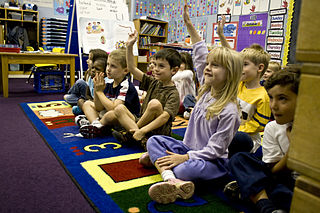
A child (pl. children) is a human being between the stages of birth and puberty, or between the developmental period of infancy and puberty. The term may also refer to an unborn human being. In English-speaking countries, the legal definition of child generally refers to a minor, in this case as a person younger than the local age of majority, regardless of their physical, mental and sexual development as biological adults. Children generally have fewer rights and responsibilities than adults. They are generally classed as unable to make serious decisions.

Kindergarten is a preschool educational approach based on playing, singing, practical activities such as drawing, and social interaction as part of the transition from home to school. Such institutions were originally made in the late 18th century in Germany, Bavaria and Alsace to serve children whose parents both worked outside home. The term was coined by German pedagogue Friedrich Fröbel, whose approach globally influenced early-years education. Today, the term is used in many countries to describe a variety of educational institutions and learning spaces for children ranging from two to six years of age, based on a variety of teaching methods.

Head Start is a program of the United States Department of Health and Human Services that provides comprehensive early childhood education, health, nutrition, and parent involvement services to low-income children and families. It is the oldest and largest program of its kind. The program's services and resources are designed to foster stable family relationships, enhance children's physical and emotional well-being, and establish an environment to develop strong cognitive skills. The transition from preschool to elementary school imposes diverse developmental challenges that include requiring the children to engage successfully with their peers outside the family network, adjust to the space of a classroom, and meet the expectations the school setting provides.

Childcare, also known as day care, is the care and supervision of one or more children, typically ranging from two weeks to 18 years old. When describing a business class, 'daycare' is usually written as a single word. Although most parents spend a significant amount of time caring for their child(ren), childcare typically refers to the care provided by caregivers who are not the child's parents. Childcare is a broad topic that covers a wide spectrum of professionals, institutions, contexts, activities, and social and cultural conventions. Early childcare is an important and often overlooked component of child development.

A preschool, also known as nursery school, pre-primary school, play school or creche, is an educational establishment or learning space offering early childhood education to children before they begin compulsory education at primary school. It may be publicly or privately operated, and may be subsidized from public funds. The typical age range for preschool in most countries is from 2 to 6 years.

Early childhood education (ECE), also known as nursery education, is a branch of education theory that relates to the teaching of children from birth up to the age of eight. Traditionally, this is up to the equivalent of third grade. ECE is described as an important period in child development.
The National Association for the Education of Young Children (NAEYC) is a large nonprofit association in the United States representing early childhood education teachers, para-educators, center directors, trainers, college educators, families of young children, policy makers, and advocates. NAEYC is focused on improving the well-being of young children, with particular emphasis on the quality of educational and developmental services for children from birth through age 8.
A preschool teacher is a person who is employed to care for children from infant to 4 years of age in a daytime setting. “Preschool“ is the category for children aged 2 to 4 years of age.

The North Carolina Department of Health and Human Services is a large state government agency in the U.S. state of North Carolina, analogous to the United States Department of Health and Human Services. The NCDHHS has more than 18,000 employees. The NCDHHS has its origins in the former North Carolina Department of Human Resources (DHR). The head of NCDHHS (Secretary) is appointed by the Governor of North Carolina, confirmed by the North Carolina Senate, and is a member of the North Carolina Cabinet in the executive branch of the North Carolina government. The NCDHHS was created in 1971.
Early childhood intervention (ECI) is a support and educational system for very young children who have been victims of, or who are at high risk for child abuse and/or neglect as well as children who have developmental delays or disabilities. Some states and regions have chosen to focus these services on children with developmental disabilities or delays, but Early Childhood Intervention is not limited to children with these disabilities.
A parent education program is a course that can be followed to correct and improve a person's parenting skills. Such courses may be general, covering the most common issues parents may encounter, or specific, for infants, toddlers, children and teenagers. These courses may also be geared towards parents who are considering having a child, or adopting one, or are pregnant.
The Child Development Associate (CDA) Credential is the most widely recognized credential in early childhood education (ECE) in the U.S. The credential is awarded by the Council for Professional Recognition. To earn a CDA, applicants must demonstrate their competency in areas which support the healthy growth and development of children, both in center-based care, family or home based care, and in home visiting programs.
Child Trends is a nonprofit, nonpartisan, research center based in Bethesda, Maryland, that conducts research on children, children's families, child well-being, and factors affecting children's lives.
Early detection of children with developmental-behavioral delays and disabilities is essential to ensure that the benefits of early intervention are maximized.

Reach Out and Read, Inc. (ROR) is a US nonprofit organization that promotes reading.
The Center for Child and Family Health (CCFH) is a collaboration between Duke University, The University of North Carolina at Chapel Hill, North Carolina Central University, Child & Parent Support Services, and the community, created to improve prevention and treatment of childhood trauma. Founded in 1996, CCFH has benefited approximately 16,000 children through direct treatment and established training programs. In addition to services delivered in the state of North Carolina, CCFH has provided assistance in the aftermath of national tragedies such as 9/11 and Hurricane Katrina.
Bright from the Start, also known as Georgia Department of Early Care and Learning, was established on July 1, 2004. The main office is located in downtown Atlanta, Georgia. The department licenses and monitors daycare centers and all state funded pre-k. Bright from the Start is headed by one commissioner and by a board of administrators. Bright from the Start provides children with quality preschool knowledge that will be necessary for their future school achievements. They want to offer a system of professional development for the providers and for the staff.
The Eastern Band of Cherokee Indians educational policies have shaped the scholastic opportunities afforded to its members. The decision of the Eastern Band of Cherokee Indians (EBCI) to take control of the schools located on the Qualla Boundary under the Tribally Controlled Schools Act of 1987 started a wave of tribal responsibility in education. EBCI Tribal Council began producing programs that aided its members in most all aspects of the educational process. The evolution of these programs, their financing, and their relationship with tribal members and non-members alike are in a constant state of flux dependent upon policies produced by the EBCI tribal council. The EBCI tribal council does not directory set educational policy, although some if its members do set on boards that govern the educational facilities, and in most cases the director of the educational programs do report to the tribal council throughout the year. The policies of the EBCI educational programs can be analyzed through their respective goals, objectives, and procedures.

Early childhood development is the period of rapid physical, psychological and social growth and change that begins before birth and extends into early childhood. While early childhood is not well defined, one source asserts that the early years begin in utero and last until 3 years of age.
Early childhood education in the United States relates to the teaching of children from birth up to the age of eight. The education services are delivered via preschools and kindergartens.









